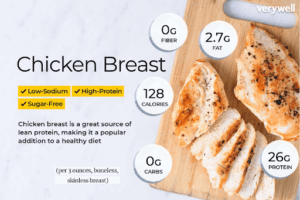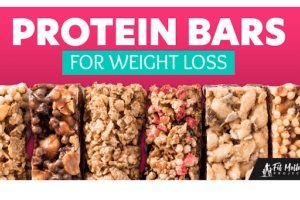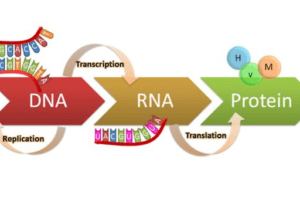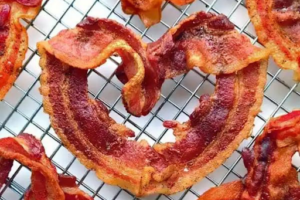Chicken breast is a popular food choice for many reasons, and its high protein content is a major perk. But exactly how much protein are we talking about in a typical serving?
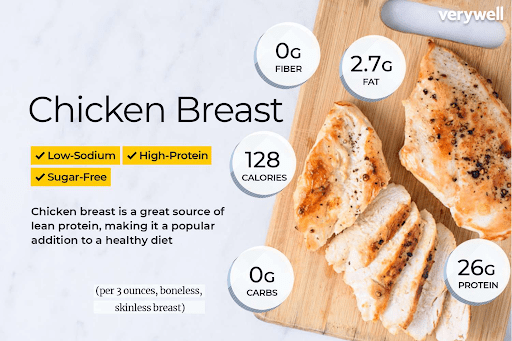
A 4-ounce serving of skinless, boneless chicken breast packs a punch with approximately 25-35 grams of protein. This variation can be due to a few factors:
- Cooking Method: Grilling or baking tends to retain more protein compared to frying.
- Brand/Source: Different chicken sources may have slight variations.
- Trimming: If any fat or connective tissue is trimmed before cooking, the protein content per weight will be slightly higher.
Beyond the Numbers: Why Protein Matters
Protein is a crucial nutrient for our bodies. It plays a key role in building and maintaining muscle, promoting satiety (feeling full), and supporting overall health. Chicken breast is a lean protein source, meaning it’s relatively low in fat while offering a high amount of protein per calorie.
Source: This information is based on data from the USDA National Nutrient Database.
Bonus: Protein in Different Chicken Cuts
| Chicken Cut | Protein per 4 oz (cooked) |
| Breast | 25-35 g |
| Thigh (skinless, boneless) | 20-25 g |
| Wings | 10-15 g |
Export to Sheets
Remember: If you’re curious about the protein content in a different serving size, simply multiply the amount per 4 oz by the desired weight ratio (e.g., 8 oz serving would be 2x the protein content of a 4 oz serving).
By understanding the protein content of chicken breast, you can make informed choices about your diet and ensure you’re getting the nutrients your body needs.
For many seeking a healthy protein boost, a 4-ounce serving of chicken breast is an excellent choice. Here’s why:
High Protein Content: As discussed previously, a 4-ounce serving delivers a substantial 25-35 grams of protein, depending on factors like cooking method and source.
Lean Protein Source: Chicken breast is naturally low in fat, especially compared to other protein sources like red meat. This makes it ideal for those watching their calorie intake or following a weight loss plan.
Bioavailability: The protein in chicken breast is considered highly bioavailable, meaning your body can easily absorb and utilize it.
How Does it Stack Up?
Compared to other readily available protein sources, 4 oz of chicken breast holds its own:
Beef (lean cut): Similar protein content (around 25-30 grams per 4 oz) but generally higher in fat.
Fish: Protein content can vary depending on the type of fish, but many offer a similar amount (around 20-30 grams per 4 oz) with potentially higher healthy fats.
Eggs: Two large eggs provide around 12 grams of protein, making them a good option but requiring a larger serving size to reach the protein level of chicken breast.
Making the Most of Your Protein:
To maximize the protein benefits of your chicken breast, consider these tips:
- Cooking Method: Opt for grilling, baking, or poaching to minimize fat loss.
- Pair it Up: Combine your chicken with vegetables or whole grains for a balanced and filling meal.
A 4-ounce serving of chicken breast is a fantastic source of protein. Its high protein content, lean nature, and bioavailability make it a valuable addition to any diet.

How many grams of protein are in a small chicken breast? (4 oz is considered a small serving)
Chicken breast reigns supreme as a protein powerhouse, and a 4-ounce serving, which is indeed considered a small size, packs a nutritious punch. Let’s delve into its protein content:
- Protein Packed: A small, 4-ounce skinless, boneless chicken breast offers approximately 25-35 grams of protein.
- Slight Variations: This range exists due to factors like:
- Cooking method: Baking or grilling tends to retain more protein compared to frying.
- Brand/Source: Different chicken sources may have minor variations.
- Trimming: If any fat or connective tissue is removed before cooking, the protein content per weight will be slightly higher.
Why Protein Matters:
Protein is a building block for our bodies. It plays a vital role in:
- Building and maintaining muscle mass
- Keeping you feeling full (satiety)
- Supporting overall health
Chicken breast is a lean protein source, meaning it’s relatively low in fat while providing a significant amount of protein per calorie. This makes it a perfect choice for various dietary needs.
Source: This information is based on data from the USDA National Nutrient Database.
Remember: If you’re cooking with a larger or smaller chicken breast, you can easily calculate the protein content. Simply multiply the amount per 4 oz (25-35 grams) by the weight ratio. For example, an 8-ounce chicken breast would likely contain 50-70 grams of protein (2 x 25-35 grams).
By understanding the protein content of a small chicken breast, you can effectively plan your meals and ensure you’re getting enough protein to support your health and fitness goals.
Chicken Breast Breakdown: Nutritional Spotlight on Protein (4 oz Serving)
Chicken breast is a staple for many reasons, and its protein content is a major draw. But what else is packed into this lean cut? Let’s break down the key nutrients in a 4-ounce serving of cooked, skinless, boneless chicken breast, with a focus on protein:
Quantity
As we know, a 4-ounce serving boasts an impressive 25-35 grams of protein, depending on factors like cooking method and source.
Quality
The protein in chicken breast is considered highly bioavailable, meaning your body can easily absorb and utilize it for building and repairing tissues.
Beyond Protein:
While protein takes center stage, here’s a glimpse into other noteworthy nutrients:
Fat: Chicken breast is naturally low in fat, typically containing around 1-4 grams per 4 oz serving. This makes it ideal for weight management or healthy eating plans.
Calories: A 4-ounce serving generally falls within the 100-140 calorie range, depending on factors like fat content.
Micronutrients: Chicken breast provides small amounts of various vitamins and minerals, including Vitamin B6, niacin, and selenium.
Making the Most of Your Chicken:
To maximize the nutritional benefits of your chicken breast:
- Cooking Method: Opt for grilling, baking, or poaching to minimize fat loss and preserve nutrients.

- Seasoning: Experiment with herbs and spices to add flavor without adding extra calories.
- Pairing: Combine your chicken with vegetables, whole grains, or healthy fats for a balanced and complete meal.
Source: This information is based on data from the USDA National Nutrient Database.
A 4-ounce serving of cooked chicken breast is a fantastic source of lean protein, with a bonus of essential vitamins and minerals. By incorporating it into balanced meals and using healthy cooking methods, you can reap the full nutritional benefits of this versatile protein source.
A 4-ounce serving of skinless, boneless chicken breast contains approximately 25-35 grams of protein. This range is due to factors like cooking method, brand, and any trimming done before cooking.
Why the Protein Amount Can Wiggle a Bit
While we said a 4-ounce chicken breast packs around 25-35 grams of protein, it’s not always an exact number. Here’s why:
Cooking it Up
Grilling or baking tends to lock in more protein compared to frying, which can involve some protein loss.
Chicken Source
Different farms or brands of chicken might have slight variations in protein content naturally.
Trim Time: If you remove any fat or connective tissue before cooking, the protein content per weight will be a bit higher since you’re starting with a leaner piece of chicken.
Chicken Breast: A Protein Powerhouse You Can Trust
Good news for protein lovers! A 4-ounce serving of skinless, boneless chicken breast delivers a whopping 25-35 grams of protein. This range can vary slightly depending on how you cook it, the brand, or if you trim any fat beforehand (think of it like a little protein wiggle room).
But here’s the real kicker: chicken breast is a lean protein source. That means it’s low in fat, making it a fantastic choice for anyone watching their calorie intake or following a healthy eating plan.
Why Protein Matters:
It plays a crucial role in:
Building and maintaining muscle: Protein helps keep your muscles strong, whether you’re a gym enthusiast or just carrying groceries.
Feeling full (satiety): Protein helps you feel satisfied after eating, which can help manage weight and avoid cravings.
This information is based on data from the highly respected USDA National Nutrient Database, so you can be confident in the protein punch you’re getting from your chicken breast.
Your Lean Protein Ally (and How Much Protein it Packs)
Calling all protein enthusiasts! A 4-ounce serving of skinless, boneless chicken breast throws down a mighty 25-35 grams of protein. This number can wiggle a bit depending on how you cook it (grilling or baking retains more protein than frying), the brand of chicken, or if you trim any fat beforehand. But that’s okay, a little protein wiggle room is normal!
Here’s the best part: chicken breast is a lean protein source, meaning it’s naturally low in fat. This makes it a champion for anyone watching their calorie intake or following a healthy eating plan.
Why Protein is Your Body’s BFF:
Building and maintaining muscle: Strong muscles are essential for everything from carrying groceries to rocking your next workout. Protein helps keep them that way.
Feeling full (satiety): Protein helps you feel satisfied after eating, which can be a lifesaver when it comes to managing weight and avoiding cravings.

Source: This information is based on reliable data from the USDA National Nutrient Database, so you can be confident you’re getting a true protein powerhouse with every bite of that chicken breast.
